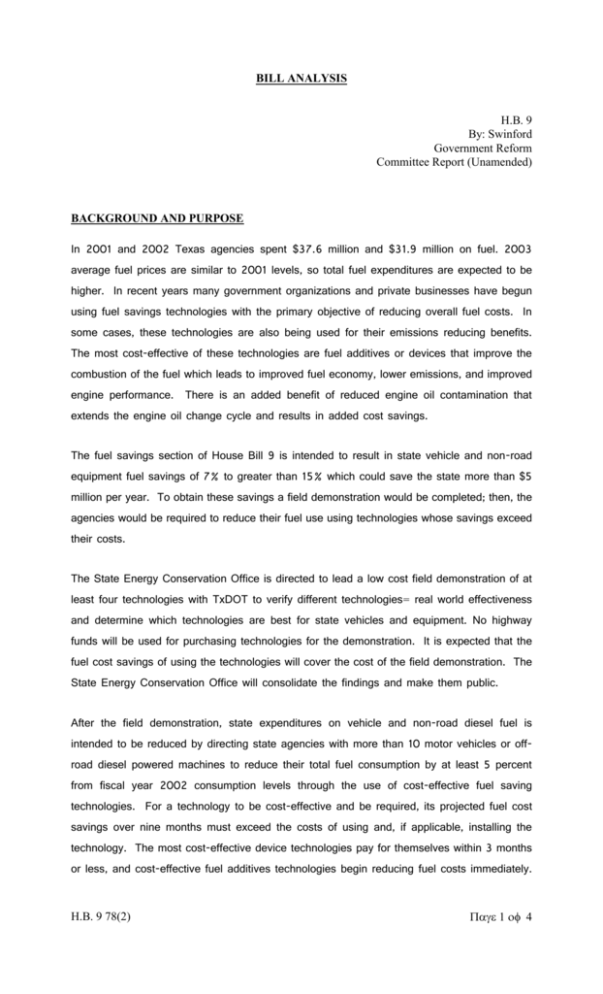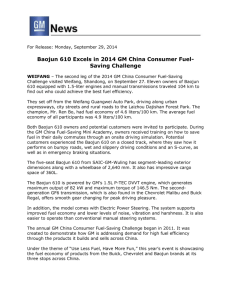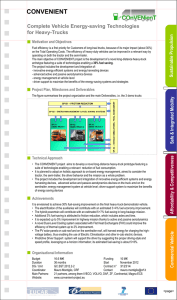BILL ANALYSIS H.B. 9 By: Swinford Government Reform Committee
advertisement

BILL ANALYSIS H.B. 9 By: Swinford Government Reform Committee Report (Unamended) BACKGROUND AND PURPOSE In 2001 and 2002 Texas agencies spent $37.6 million and $31.9 million on fuel. 2003 average fuel prices are similar to 2001 levels, so total fuel expenditures are expected to be higher. In recent years many government organizations and private businesses have begun using fuel savings technologies with the primary objective of reducing overall fuel costs. In some cases, these technologies are also being used for their emissions reducing benefits. The most cost-effective of these technologies are fuel additives or devices that improve the combustion of the fuel which leads to improved fuel economy, lower emissions, and improved engine performance. There is an added benefit of reduced engine oil contamination that extends the engine oil change cycle and results in added cost savings. The fuel savings section of House Bill 9 is intended to result in state vehicle and non-road equipment fuel savings of 7% to greater than 15% which could save the state more than $5 million per year. To obtain these savings a field demonstration would be completed; then, the agencies would be required to reduce their fuel use using technologies whose savings exceed their costs. The State Energy Conservation Office is directed to lead a low cost field demonstration of at least four technologies with TxDOT to verify different technologies= real world effectiveness and determine which technologies are best for state vehicles and equipment. No highway funds will be used for purchasing technologies for the demonstration. It is expected that the fuel cost savings of using the technologies will cover the cost of the field demonstration. The State Energy Conservation Office will consolidate the findings and make them public. After the field demonstration, state expenditures on vehicle and non-road diesel fuel is intended to be reduced by directing state agencies with more than 10 motor vehicles or offroad diesel powered machines to reduce their total fuel consumption by at least 5 percent from fiscal year 2002 consumption levels through the use of cost-effective fuel saving technologies. For a technology to be cost-effective and be required, its projected fuel cost savings over nine months must exceed the costs of using and, if applicable, installing the technology. The most cost-effective device technologies pay for themselves within 3 months or less, and cost-effective fuel additives technologies begin reducing fuel costs immediately. H.B. 9 78(2) 14 After the fuel savings pay for the technology, the State is expected to save more than $5 million each year depending on fuel costs and the technologies selected. Texas is also leading the nation in overall energy consumption and industrial electric consumption. New technologies can help reduce the amount of energy the state needs by improving energy efficiency. Many governments and large private companies have discovered that one of the best strategies for reducing energy use involves entering into energy saving performance contracts. During the 77th Legislative Session, HB 2277 was passed to make it easier for agencies to enter into these contracts. House Bill 9 encourages agencies to look at how to maximize the savings to the state and minimize capital expenditures by utilizing the money generated by utility cost savings contracts. RULEMAKING AUTHORITY It is the committee=s opinion that this bill does not expressly grant any rulemaking authority to a state officer, department, agency, or institution. ANALYSIS SECTION I: Amends Chapter 447 of the Government Code by adding Section 447.010 FUEL SAVINGS FOR STATE AGENCIES and Section 447.011 FIELD DEMONSTRATIONS as follows: Section 447.010 FUEL SAVINGS FOR STATE AGENCIES: Provides definitions for Acost-effective@, Afuel-saving technology@, and Aproven fuel-saving technologies@ for both Section 447.010 and Section 447.011. Requires a state agency with 10 or more vehicles or non-road diesels to reduce their total fuel consumption by at least five percent through cost-effective fuel-saving technologies. Allows a state agency to delay reducing fuel use until a list of proven fuel-saving technologies is available from the state energy conservation office=s field demonstrations. Mandates a state agency may not purchase/use a fuel-saving technology that is known to increase specified air pollutants, degrade human health, or negatively impact the environment. Provides for the refund of fuel-saving technologies that prove to be ineffective at reducing fuel use by five percent. Allows state agencies to establish a program for employees to voluntarily purchase fuel-saving technologies and document reductions. Requires each state agency to annually report to the state energy conservation office, on forms provided by that office, the efforts and progress of reducing fuel use. Section 447.011 FIELD DEMONSTRATIONS : H.B. 9 78(2) 24 Requires the Texas Department of Transportation, under direction of the state energy conservation office, to demonstrate the effectiveness of at least four fuel-saving technologies using a total of 100 motor vehicles or non-road diesels of varying ages and types with preference given to high-use vehicles. The technology=s performance in the normal course of operation and in controlled field tests will be assessed. In selecting technologies to evaluate, requires the state energy conservation office to consult with other entities using fuel-saving technologies, consider technologies already proven to demonstrate benefits of five % or more and determine the potential cost-effectiveness. Fuel-saving technologies are to be disqualified if it reduces engine performance, requires additional maintenance or degrades air quality. Allows TCET, UT Center for Transportation Research, UH Diesel Emissions Center, or other agencies to assist in the field trials. Requires the state energy conservation office to rank the technologies, list recommendations, document positive and negative effects, and prepare a report of these findings. The agency is required to provide the report to each state agency with 10 or more motor vehicles or non-road diesels and to the Legislative Budget Board by September 1, 2004. The agency will make the results of the demonstration public on its website and is required to update the list of proven fuel-saving technologies quarterly on its website. The Texas Council on Environmental Technology is to obtain information on specific fuel-saving technology and can use this information to fund EPA verification. Mandates that money from the state highway fund can not be used to purchasing, installing, maintaining, or operating fuel-saving technologies being assessed or tested. Repairs resulting from demonstrations must be paid from the same funds used to implement this section. SECTION 2: Amends Chapter 2113 of the Government Code by adding Subchapter E. RESTRICTIONS ON CAPITAL EXPENDITURES as follows: Section 2113.301 PREFERENCE FOR FINANCING CERTAIN CAPITAL EXPENDITURES WITH MONEY GENERATED BY UTILITY COST SAVINGS CONTRACT: Provides definitions for Astate facility purpose@and Autility cost savings contract@. Requires a state agency before making a capital expenditure with appropriated money to determine if the expenditure could be financed by money generated through reducing energy or water consumption or operating costs. Requires a state agency, if able, to use money saved through a utility cost savings contract to finance H.B. 9 78(2) 34 a capital expenditure for a state facility purpose instead of using appropriated money. If the agency is not able to do so, justification must be provided to the LBB for the capital expenditure. The agency must take into account when determining if a utility cost savings contract can finance the capital expenditure, whether utility cost savings in a department can be used to finance capital expenditures for any other department of the agency. SECTION 3: Effective date. EFFECTIVE DATE December 1, 2003. H.B. 9 78(2) 44








